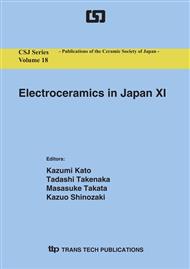p.191
p.195
p.201
p.205
p.209
p.213
p.217
p.221
p.225
Effect of Template Particle Formation on Texture Development in Bi0.5Na0.5TiO3 Ceramics
Abstract:
The factor determining texture development was examined for Bi0.5Na0.5TiO3 ceramics made by the reactive-templated grain growth process using platelike Bi4Ti3O12 particles as reactive template. Platelike, skeleton Bi0.5Na0.5TiO3 particles were formed by the reaction between Bi4Ti3O12 and Na2CO3 in calcined compacts. Coalescence of small grains in the skeleton particles to form single template particles was important to obtain highly textured ceramics.
Info:
Periodical:
Pages:
209-212
Citation:
Online since:
September 2008
Authors:
Price:
Сopyright:
© 2009 Trans Tech Publications Ltd. All Rights Reserved
Share:
Citation:


